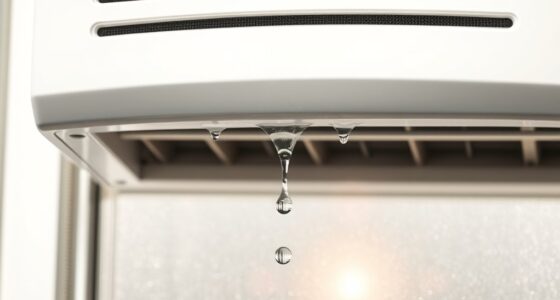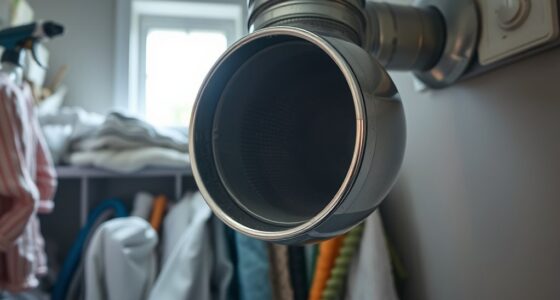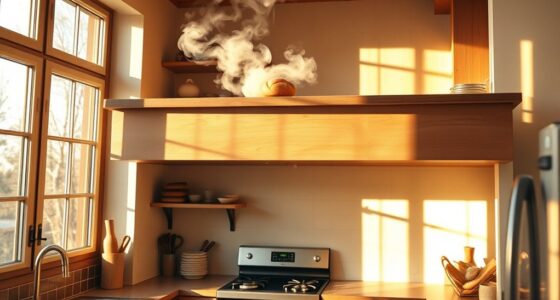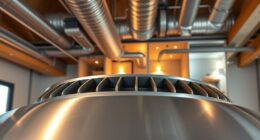To save money, check your filters every 1-3 months. Clean reusable filters when airflow drops or they appear dusty, typically every 4-6 weeks. Replace disposable filters when airflow decreases or visibility shows heavy dirt, usually every 1-3 months. Seasonal checks help you stay ahead, preventing costly repairs and boosting efficiency. Keep track of signs and schedules to maintain supreme performance—discover more tips for smart filtering below.
Key Takeaways
- Replace disposable filters every 1-3 months to maintain efficiency and prevent increased energy costs.
- Clean reusable filters every 4-6 weeks to prolong lifespan and ensure optimal airflow.
- Watch for signs like reduced airflow, visible dirt, and allergies to determine when to replace or clean filters.
- Check filters seasonally or environmental changes to adjust cleaning or replacement frequency accordingly.
- Proper filter maintenance improves HVAC efficiency, reduces energy bills, and extends system lifespan.
Understanding Different Types of HVAC Filters

Choosing the right HVAC filter starts with understanding the different types available. Air purifier filters come in various forms, such as HEPA, activated carbon, and electrostatic filters, each designed to target specific pollutants. Furnace filter ratings, like the MERV (Minimum Efficiency Reporting Value), help you gauge how effectively a filter captures particles. A higher MERV rating means better filtration but may restrict airflow if your system isn’t compatible. Basic fiberglass filters are budget-friendly but offer minimal filtration, while pleated filters provide a balance of cost and performance. Knowing the differences helps you select a filter that suits your needs and system, ensuring cleaner air and efficient operation. Always check your HVAC system’s specifications to choose the most appropriate filter type and rating.
Signs Your Filter Needs Immediate Attention

If you notice your HVAC system isn’t performing as efficiently as it used to, it’s a strong sign that your filter may need immediate attention. Poor airflow can lead to decreased air quality, making your indoor environment less healthy. You might also experience an increase in filter allergies, with symptoms like sneezing or congestion worsening. A clogged or dirty filter restricts airflow, forcing your system to work harder and reducing its effectiveness. Additionally, persistent musty odors or visible dust accumulation around vents suggest your filter isn’t doing its job. Addressing these signs promptly helps maintain good air quality and prevents system strain. Regularly checking your filter condition can help you identify when it’s time to replace or clean your filter to ensure *ideal* performance and healthier indoor air.
When to Clean Reusable Filters for Optimal Performance

When you notice your filter isn’t trapping dust or airflow seems reduced despite regular checks, it’s time to clean your reusable filter. Regular filter cleaning guarantees peak performance and prolongs the filter’s lifespan. Typically, reusable filters should be cleaned every 4 to 6 weeks, but this varies based on usage and environment. If your space is dusty or polluted, more frequent cleaning might be necessary. Use a gentle brush or water to remove debris without damaging the filter material. To stay on top of maintenance, consider this schedule:
| Frequency | Indicators | Methods |
|---|---|---|
| Every 4-6 weeks | Reduced airflow, dust buildup | Vacuum or rinse with water |
| After heavy dusting | Visible dirt or debris | Soak and scrub lightly |
| Monthly or as needed | Persistent odors or allergens | Use mild soap |
| During seasonal changes | Increased dust levels | Deep clean |
| When airflow drops noticeably | Filter looks dirty | Complete cleaning |
Additionally, monitoring the air quality indicators can help determine when cleaning is necessary.
Indicators That It’s Time to Replace Disposable Filters

Knowing the signs that your disposable filter needs replacing can save you money and maintain indoor air quality. One key replacement indicator is the filter’s lifespan; most filters last about 1 to 3 months, depending on usage and air quality. If you notice reduced airflow or increased dust and allergies, it’s a clear sign your filter is overloaded and needs replacing. Visible dirt buildup or discoloration also signals that the filter has reached its limit. Additionally, if your energy bills rise unexpectedly, it may mean the filter isn’t functioning properly, forcing your system to work harder. Pay attention to these replacement indicators—ignoring them can lead to decreased efficiency, higher costs, and compromised air quality. Regular filter maintenance helps ensure optimal performance and health, preventing unnecessary strain on your air purifier. Replacing a filter at the right time guarantees maximum performance and health.
Creating a Seasonal Filter Maintenance Schedule

Establishing a seasonal filter maintenance schedule helps you stay ahead of potential issues and keeps your system running efficiently year-round. Regularly adjusting your filter routine ensures better air quality and allergen control, especially during peak seasons. To create an effective schedule, consider these tips:
- Check filters at the start of each season to determine if cleaning or replacement is needed
- Mark calendar reminders to stay consistent
- Adjust frequency based on allergy sensitivities or indoor air quality concerns
- Keep spare filters accessible for quick changes during peak allergy seasons
- Incorporate filter toppers to enhance comfort and prolong the lifespan of your filters.
Factors Affecting Filter Longevity and Performance

Several factors influence how long your filters last and how well they perform, directly impacting your air quality and allergen reduction. The amount of dust, pollen, pet dander, and other pollutants in your environment determines how quickly a filter becomes clogged. High levels of airborne particles mean you’ll need to replace or clean filters more often. The type of filter also matters; higher-efficiency filters can improve air quality but may clog faster if exposed to heavy pollutants. Your system’s usage and airflow rate affect filter longevity too—more frequent operation or high airflow speeds can cause quicker wear. Regularly monitoring your indoor air quality helps you understand when to replace or clean filters for optimal allergen reduction and system performance. Proper maintenance practices also play a key role in extending filter life and ensuring consistent air cleaning.
Cost-Effective Tips for Maintaining Your Filters

Regularly inspecting your filters helps catch issues early and extend their life. Using proper cleaning techniques guarantees they work efficiently without unnecessary replacements. Knowing when to replace filters keeps your system running smoothly and saves you money in the long run. Additionally, understanding the mechanics of filters can help identify signs of wear before performance declines.
Regular Inspection Routines
By performing routine inspections on your filters, you can catch dirt and debris early before they reduce airflow or cause damage. This simple step helps maintain ideal air quality and allergen control in your space. During inspections, look for signs like excessive dust buildup, discoloration, or a noticeable decrease in airflow. Regular checks also help identify when filters are still effective or need replacing. Keep these tips in mind:
- Check filters every 1-3 months, depending on usage
- Look for visible dirt, mold, or debris
- Ensure filters fit securely without gaps
- Note any unusual odors or airflow issues
- Energy-efficient filters may last longer with proper maintenance
Sticking to an inspection routine saves money by preventing premature replacements and keeps your environment healthier. Staying proactive ensures your filters perform well and maintain good air quality.
Optimal Cleaning Techniques
Cleaning your filters properly can extend their lifespan and save you money, so it’s essential to use techniques that are both effective and cost-efficient. Regular, gentle cleaning removes dust and debris, improving air quality and allergen reduction. Avoid harsh chemicals that can damage filters; instead, use mild soap and water. Make sure to dry filters thoroughly before reinstalling to prevent mold. Here’s a quick guide:
| Cleaning Method | Benefits |
|---|---|
| Gentle brushing | Removes surface dust efficiently |
| Mild soap and water | Restores filter clarity |
| Air drying | Prevents mold buildup |
Using proper cleaning techniques can further enhance filter longevity and performance.
When to Replace Filters
Knowing when to replace your filters is key to maintaining efficient airflow and saving money. If your air quality drops or allergens become more noticeable, it’s time for a change. Don’t wait until filters are visibly dirty; trust your senses and these signs:
- Reduced airflow from vents
- Persistent dust or allergens in the air
- Unpleasant odors despite cleaning
- Increased allergy symptoms
Replacing filters at the right time enhances allergen control and keeps your HVAC system running smoothly. Regularly check your filters every 1-3 months, especially during allergy season or periods of heavy use. Proper timing prevents strain on your system, improves air quality, and saves money in the long run. Stay proactive to ensure a healthier, cleaner environment in your home. Additionally, understanding filter spoilage signs helps prevent using ineffective filters.
The Impact of Proper Filter Maintenance on Energy Bills

When you maintain your air filters properly, you can considerably reduce your energy bills. Clean filters allow your HVAC system to operate efficiently, using less energy to heat or cool your home. When filters are clogged or dirty, the system works harder, consuming more power and increasing your bills. Additionally, a well-maintained filter improves air quality by reducing dust, allergens, and other particles, which supports allergen control and promotes healthier indoor environments. Regularly replacing or cleaning filters ensures ideal airflow, preventing strain on your system. Kia Tuning techniques can also optimize system performance and efficiency. This not only saves money but also extends the lifespan of your HVAC units. Proper filter maintenance is a simple yet effective way to lower energy costs while maintaining a comfortable, healthy home.
Tips for Choosing the Right Filter for Your Home

Choosing the right filter for your home depends on understanding different filter types and ensuring compatibility with your system. You should also consider how easy it is to maintain and replace the filter regularly. Making informed choices can save you money and improve your indoor air quality. Additionally, selecting filters with appropriate filter efficiency ratings can enhance purification performance while minimizing operational costs.
Filter Types and Compatibility
Selecting the right filter type for your home is essential to guarantee efficient performance and cost savings. Your choice impacts filter durability and how well your air purifier works. Consider compatibility with your device to avoid unnecessary replacements or damage. Additionally, understanding the different filter styles, such as those suited for a bedroom environment, can help optimize air quality and comfort.
Maintenance and Replacement Tips
Proper maintenance and timely replacement of your filters are key to guaranteeing your air purifier performs efficiently and continues to save you money. Regularly inspect your filter’s condition to maintain peak air quality and extend its lifespan. Clean or replace filters according to the manufacturer’s recommendations—usually every 3 to 6 months—to prevent buildup of dust, allergens, and other particles that can impair performance. Choosing the right filter for your home’s needs also matters; consider factors like filter type, size, and efficiency. Remember, a filter that’s too old or clogged reduces air quality and forces your system to work harder, increasing energy costs. Staying proactive with maintenance ensures cleaner air and maximizes your investment. Additionally, selecting the appropriate filter material can further enhance filtration efficiency and longevity.
Frequently Asked Questions
How Do Indoor Air Quality Levels Influence Filter Replacement Timing?
Your indoor air quality levels directly impact filter replacement timing. If air quality standards decline or you notice increased dust and allergens, it signals that your filtration effectiveness is compromised, and you should replace or clean your filter. Regularly monitoring air quality helps you maintain ideal filtration, ensuring healthier indoor air. When air quality worsens, timely filter replacement keeps your system efficient and improves overall air cleanliness.
Can Using a Higher Merv-Rated Filter Improve Energy Efficiency?
Using a higher MERV-rated filter can improve energy efficiency if it’s made from high-quality filter material and properly fitted. It enhances airflow optimization by trapping more particles without restricting airflow, which reduces strain on your HVAC system. However, if the filter is too dense, it may hinder airflow and increase energy use. Make sure to select a filter with the right balance for your system to maximize efficiency and indoor air quality.
Are There Environmental Benefits to Choosing Reusable Filters Over Disposables?
Think of reusable filters as the green thumbs of your HVAC system. Choosing them offers notable recycling benefits and reduces landfill waste, making your home more eco-friendly. These filters are made from sustainable materials, which cut down on disposable waste and energy used in manufacturing new filters. By switching to reusable options, you actively support environmental health, helping to preserve our planet for future generations while keeping your indoor air clean.
What Are the Cost Differences Between Regular Cleaning and Replacement?
A cost comparison shows cleaning filters is generally cheaper in the short term, saving you money on replacement expenses. Cleaning filters costs only your time and a bit of effort, while replacements can add up over time, especially if you replace them frequently. However, if filters are heavily soiled or damaged, replacing them might be more cost-effective in the long run, ensuring efficiency and better indoor air quality.
How Do Climate Conditions Affect Filter Lifespan and Maintenance Needs?
Climate conditions greatly impact your filter’s lifespan. High humidity increases mold growth and dust accumulation, making filters clog faster and requiring more frequent cleaning or replacement. Conversely, dry environments reduce dust buildup, extending filter life. In humid climates, you should check filters more often and replace them sooner, while in dry areas, regular cleaning may suffice longer. Adjust your maintenance schedule based on these climate effects to save money and ensure clean air.
Conclusion
By staying attentive to your filter’s needs, you can save money and keep your HVAC running smoothly. Regular cleaning and timely replacements prevent costly repairs and improve efficiency. Remember, an ounce of prevention is worth a pound of cure—so don’t wait until it’s too late. With a proactive approach, you’ll enjoy cleaner air, lower energy bills, and a healthier home all year round.









